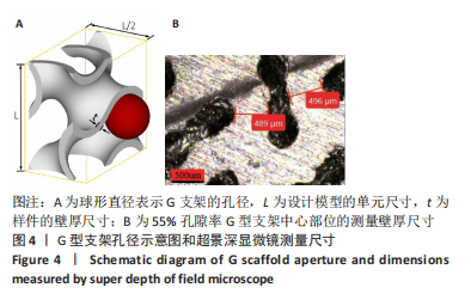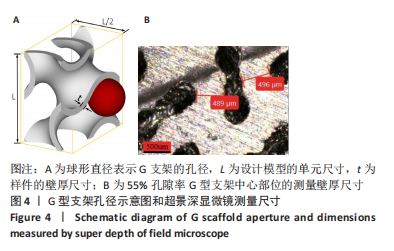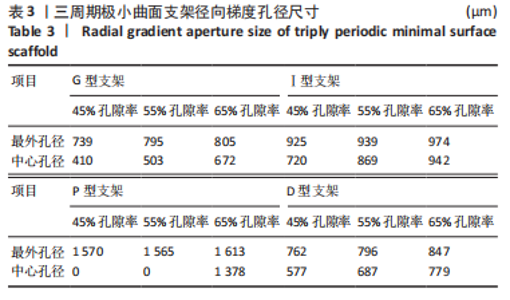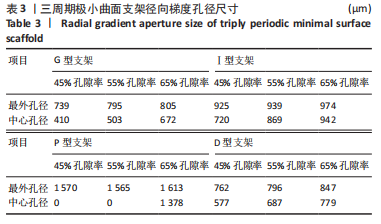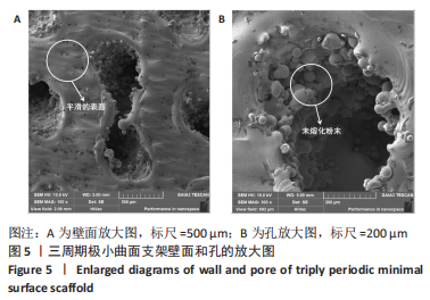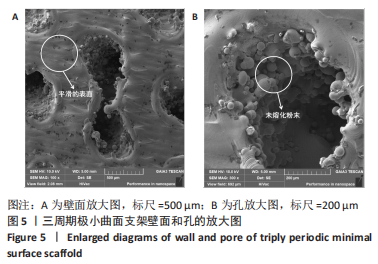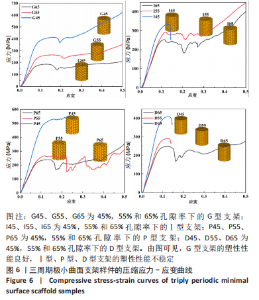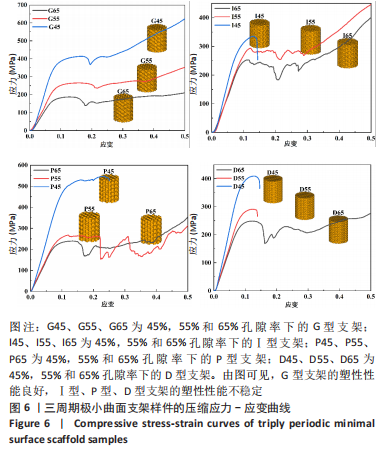Chinese Journal of Tissue Engineering Research ›› 2024, Vol. 28 ›› Issue (5): 741-746.doi: 10.12307/2024.253
Previous Articles Next Articles
Structural design and mechanical property analysis of trabecular scaffold of triply periodic minimal surface with a radial gradient
Zhang Yihai1, Shang Peng1, Ma Benyuan1, Hou Guanghui1, Cui Lunxu1, Song Wanzhen1, Qi Dexuan1, Liu Yancheng2
- 1School of Mechanical Engineering, Hebei University of Technology, Tianjin 300401, China; 2Tianjin Hospital, Tianjin University, Tianjin 300211, China
-
Received:2022-12-26Accepted:2023-03-06Online:2024-02-18Published:2023-08-16 -
Contact:Shang Peng, MD, Associate professor, Master’s supervisor, School of Mechanical Engineering, Hebei University of Technology, Tianjin 300401, China Liu Yancheng, MD, Associate chief physician, Tianjin Hospital, Tianjin University, Tianjin 300211, China -
About author:Zhang Yihai, Master candidate, School of Mechanical Engineering, Hebei University of Technology, Tianjin 300401, China Shang Peng, MD, Associate professor, School of Mechanical Engineering, Hebei University of Technology, Tianjin 300401, China -
Supported by:General Program of Hebei Natural Science Foundation, No. E2022202164 (to SP); Key Research Project of Hebei Provincial Department of Education, No. ZD2020124 (to SP); Wu Jieping Medical Foundation Project, No. 320.6750.2022-18-49 (to LYC); Beijing Medical and Health Public Welfare Foundation Project, No. B20371FN (to LYC)
CLC Number:
Cite this article
Zhang Yihai, Shang Peng, Ma Benyuan, Hou Guanghui, Cui Lunxu, Song Wanzhen, Qi Dexuan, Liu Yancheng. Structural design and mechanical property analysis of trabecular scaffold of triply periodic minimal surface with a radial gradient[J]. Chinese Journal of Tissue Engineering Research, 2024, 28(5): 741-746.
share this article
Add to citation manager EndNote|Reference Manager|ProCite|BibTeX|RefWorks
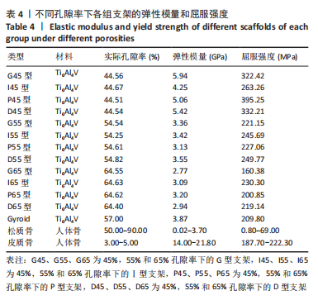
由图6可知,G型支架的变形从弹性变形阶段开始,然后达到长塑性屈服平台阶段,在此阶段应力波动较小,最后到达致密化阶段,没有出现失效断裂。Ⅰ型支架、P型支架和D型支架的不同孔隙率样件有着不同的材料变形行为,在45%孔隙率时,Ⅰ型支架和D型支架在屈服平台的初始阶段发生断裂,P支架在经过一定屈服平台阶段后也发生断裂;在55%孔隙率时,Ⅰ型支架和P型支架在屈服平台阶段应力出现一定波动,P型支架的应力波动幅度较大,D型支架在屈服平台初始阶段发生断裂;在65%孔隙率时,另3种支架的材料变形行为与G型支架相似,没有出现失效断裂,但与G型支架相比,它们的屈服平台阶段应力波动幅度较大。因此,G型支架是4种支架中塑性最好的支架,可用作骨植入物。 表4总结了此次实验中的4种支架、文献中的Gyroid支架[13]、松质骨和皮质骨的弹性模量和压缩屈服强度[22]。"
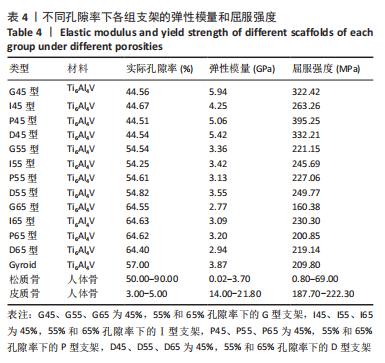
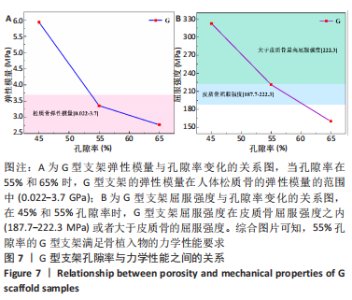
通过表4可以看出,成型试件的孔隙率比设计孔隙率有所下降,这种微小的偏差是由于支架表面上的粉末结块造成的,无法通过简单的机械方法去除。G型支架在3种孔隙率下的力学性能有较大差异,由图7可知,G型支架的弹性模量和屈服强度随孔隙率的升高而降低。由图7A可知,当孔隙率在55%和65%时,G型支架的弹性模量在人体松质骨的弹性模量的范围中(0.022-3.7 GPa)。由图7B可知,在45%和55%孔隙率时,G型支架屈服强度在皮质骨屈服强度之内(187.7-222.3 MPa)或者大于皮质骨的屈服强度。因此,结合弹性模量和屈服强度,55%孔隙率的G型支架具有匹配松质骨的弹性模量,能有效降低应力屏蔽效应,并且具有较高屈服强度,可以承受较高载荷而不发生断裂,满足骨植入物的力学性能要求。"
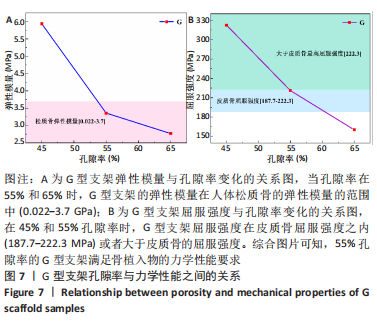
| [1] MIRKHALAF M, DAO A, SCHINDELER A, et al. Personalized Baghdadite scaffolds: stereolithography, mechanics and in vivo testing. Acta Biomater. 2021;132:217-226. [2] HU S, YANG X, WU H, et al. Lotus sprout-templated porous cobalt-doped borate bioglass with antibacterial properties and multiple-layered osteogenic promotion. Appl Mater Today. 2022;29:101678. [3] MA Z, XIE J, SHAN XZ, et al. High solid content 45S5 Bioglass®-based scaffolds using stereolithographic ceramic manufacturing: process, structural and mechanical properties. J Mech Sci Technol. 2021;35(2): 823-832. [4] CHEN Z, CHEN Y, DING J, et al. Blending strategy to modify PEEK-based orthopedic implants. Compos Part B. 2023;250:110427. [5] MIRKHALAF M, ZREIQAT H. Fabrication and Mechanics of Bioinspired Materials with Dense Architectures: Current Status and Future Perspectives. JOM. 2020;72(4):1458-1476. [6] SZYMCZYK-ZIÓŁKOWSKA P, ŁABOWSKA MB, DETYNA J, et al. A review of fabrication polymer scaffolds for biomedical applications using additive manufacturing techniques. Biocybern Biomed Eng. 2020;40(2): 624-638. [7] NI J, LING H, ZHANG S, et al. Three-dimensional printing of metals for biomedical applications. Mater Today Bio. 2019;3:100024. [8] LV Y, WANG B, LIU G, et al. Design of bone-like continuous gradient porous scaffold based on triply periodic minimal surfaces. J Mater Res Technol. 2022;21:3650-3665. [9] MIRKHALAF M, MEN Y, WANG R, et al. Personalized 3D printed bone scaffolds: A review. Acta Biomater. 2023;156:110-124. [10] MIRKHALAF M, WANG X, ENTEZARI A, et al. Redefining architectural effects in 3D printed scaffolds through rational design for optimal bone tissue regeneration. Appl Mater Today. 2021;25:101168. [11] ARMIENTO AR, HATT LP, SANCHEZ ROSENBERG G, et al. Functional Biomaterials for Bone Regeneration: A Lesson in Complex Biology. Adv Funct Mater. 2020;30(44):1909874. [12] ARAMIAN A, RAZAVI SMJ, SADEGHIAN Z, et al. A review of additive manufacturing of cermets. Addit Manuf. 2020;33:101130. [13] ZHANG J, CHEN X, SUN Y, et al. Design of a biomimetic graded TPMS scaffold with quantitatively adjustable pore size. Mater Des. 2022;218: 110665. [14] VIET NV, WAHEED W, ALAZZAM A, et al. Effective compressive behavior of functionally graded TPMS titanium implants with ingrown cortical or trabecular bone. Compos Struct. 2023;303:116288. [15] LI Z, CHEN Z, CHEN X, et al. Effect of unit configurations and parameters on the properties of Ti–6Al–4V unit-stacked scaffolds: A trade-off between mechanical and permeable performance. J Mech Behav Biomed Mater. 2021;116:104332. [16] YU A, ZHANG C, XU W, et al. Additive manufacturing of multi-morphology graded titanium scaffolds for bone implant applications. J Mater Sci Technol. 2023;139:47-58. [17] MASKERY I, AREMU AO, PARRY L, et al. Effective design and simulation of surface-based lattice structures featuring volume fraction and cell type grading. Mater Des. 2018;155:220-232. [18] AL-KETAN O, ABU AL-RUB RK. MSLattice: A free software for generating uniform and graded lattices based on triply periodic minimal surfaces. Mater Des Process Commun. 2021;3(6):e205. [19] POLTUE T, KARUNA C, KHRUEADUANGKHAM S, et al. Design exploration of 3D-printed triply periodic minimal surface scaffolds for bone implants. Int J Mech Sci. 2021;211:106762. [20] WANG P, LI X, JIANG Y, et al. Electron beam melted heterogeneously porous microlattices for metallic bone applications: Design and investigations of boundary and edge effects. Addit Manuf. 2020;36: 101566. [21] LI X, XIAO L, SONG W. Compressive behavior of selective laser melting printed Gyroid structures under dynamic loading. Addit Manuf. 2021; 46:102054. [22] WANG X, XU S, ZHOU S, et al. Topological design and additive manufacturing of porous metals for bone scaffolds and orthopaedic implants: A review. Biomaterials. 2016;83:127-141. [23] 刘佳辛,贾鹏,门玉涛,等.基于三周期极小曲面骨小梁结构的设计及优化[J].中国组织工程研究,2023,27(7): 992-997. [24] BIEMOND JE, AQUARIUS R, VERDONSCHOT N, et al. Frictional and bone ingrowth properties of engineered surface topographies produced by electron beam technology. Arch Orthop Trauma Surg. 2011;131(5): 711-718. [25] AMBU R, MORABITO AE. Modeling, Assessment, and Design of Porous Cells Based on Schwartz Primitive Surface for Bone Scaffolds. Sci World J. 2019;2019:1-16. [26] MYAKININ A, TURLYBEKULY A, POGREBNJAK A, et al. In vitro evaluation of electrochemically bioactivated Ti6Al4V 3D porous scaffolds. Mater Sci Eng C. 2021;121:111870. [27] MURCHIO S, DALLAGO M, ZANINI F, et al. Additively manufactured Ti–6Al–4V thin struts via laser powder bed fusion: Effect of building orientation on geometrical accuracy and mechanical properties. J Mech Behav Biomed Mater. 2021;119:104495. [28] BARBA D, ALABORT C, TANG YT, et al. On the size and orientation effect in additive manufactured Ti-6Al-4V. Mater Des. 2020;186:108235. [29] NOOEAID P, SALIH V, BEIER JP, et al. Osteochondral tissue engineering: scaffolds, stem cells and applications. J Cell Mol Med. 2012;16(10): 2247-2270. [30] 曾寿金,刘广,李传生,等.基于SLM的股骨柄多孔结构设计与力学性能分析[J].中国激光,2022,49(2):174-187. |
| [1] | Wang Jianchun, Yang Shuqing, Su Xin, Wang Hongyuan. Different contents of B2O3 affect mechanical properties and bioactivity of bioactive glass scaffolds [J]. Chinese Journal of Tissue Engineering Research, 2024, 28(5): 712-716. |
| [2] | Lan Weiwei, Yu Yaodong, Huang Di, Chen Weiyi. In vitro degradation behavior of Mg-Zn-Ca alloys [J]. Chinese Journal of Tissue Engineering Research, 2024, 28(5): 717-723. |
| [3] | Wei Yuxue, Wang Di, Liu Xiaoqiu. Design, synthesis and properties of oral composite resin monomers with different photoinitiators [J]. Chinese Journal of Tissue Engineering Research, 2024, 28(5): 731-735. |
| [4] | Cheng Jinhui, Wu Quan, Peng Min, Huang Changli, Tian Huimin, Li Yang. Preparation and properties of selective laser melting of porous titanium at a low energy density [J]. Chinese Journal of Tissue Engineering Research, 2024, 28(5): 664-668. |
| [5] | He Yinhao, Li Xiaosheng, Chen Hongwen, Chen Tiezhu. 3D printed porous tantalum metal in the treatment of developmental dysplasia of the hip: current status and application prospect [J]. Chinese Journal of Tissue Engineering Research, 2023, 27(9): 1455-1461. |
| [6] | Liu Jiaxin, Jia Peng, Men Yutao, Liu Lu, Wang Yeming, Ye Jinduo. Design and optimization of bone trabecular structure with triply periodic minimal surfaces [J]. Chinese Journal of Tissue Engineering Research, 2023, 27(7): 992-997. |
| [7] | Deng Moyuan, Peng Kun. Role and regulation of macrophages in biomaterial-mediated fibrosis formation [J]. Chinese Journal of Tissue Engineering Research, 2023, 27(25): 4085-4092. |
| [8] | Lyu Jiayi, Yao Qingqiang, Zhu Yishen. Role and advantages of carbon nanotubes for tissue engineering [J]. Chinese Journal of Tissue Engineering Research, 2023, 27(25): 4093-4100. |
| [9] | Chen Jianquan, Chen Maoshui, Lyu Zhouming, Chen Rongbin, Yu Zhaoyu, Liu Wanpeng, Lin Xinyuan, Lin Dingkun. Biomechanical properties of cortical bone trajectory combined with pedicle screw fixation on vertebral body motion unit: a finite element analysis [J]. Chinese Journal of Tissue Engineering Research, 2023, 27(22): 3457-3462. |
| [10] | Li Jingna, Zeng Qingfeng, Yu Shuyin, Qin Yue, Ai Zizheng, Dong Xieping. Preparation and properties of porous hydroxyapatite scaffolds with biphase calcium phosphate coating [J]. Chinese Journal of Tissue Engineering Research, 2023, 27(16): 2493-2500. |
| [11] | Niu Jingwei, Zhang Qingtao, Wang Na, Guan Shuo, Wang Ying. Correlation analysis between thyroid function-related Thrβ and Thrsp genes and mechanical properties of Achilles tendon development in rats [J]. Chinese Journal of Tissue Engineering Research, 2023, 27(11): 1653-1658. |
| [12] | Wang Jinsi, Wang Shengfa, Wu Zhuguo, He Xiaoling, Wang Xinyu, Luo Xiaoyu, Zhao Yi, Zhang Jingying. Design and biological activity of beta-tricalcium phosphate biomimetic bone scaffold based on triply periodic minimal surfaces [J]. Chinese Journal of Tissue Engineering Research, 2022, 26(21): 3291-3297. |
| [13] | Feng Chen, Zhou Jiping, Xu Xiaodong, Jiang Yani, Shi Hongcan, Zhao Guoqi. Design of an automatic measurement system for the micro-mechanical properties of three-dimensional printing biomaterials [J]. Chinese Journal of Tissue Engineering Research, 2022, 26(21): 3306-3311. |
| [14] | Liu Qingbo, Su Zhiyang, Wang Hengfeng, Zhao Yu, Lyu Jia. Biomechanical properties of trabecular bone prosthesis with triply periodic minimal surfaces unit structure [J]. Chinese Journal of Tissue Engineering Research, 2022, 26(15): 2297-2301. |
| [15] | Sun Qi, Zhou Yanan, Dong Xin, Li Ning, Yan Jiazhen, Shi Haojiang, Xu Sheng, Zhang Biao. Metal-ceramic interface characteristics of Co-Cr alloy fabricated by selective laser melting [J]. Chinese Journal of Tissue Engineering Research, 2021, 25(4): 521-525. |
| Viewed | ||||||
|
Full text |
|
|||||
|
Abstract |
|
|||||
